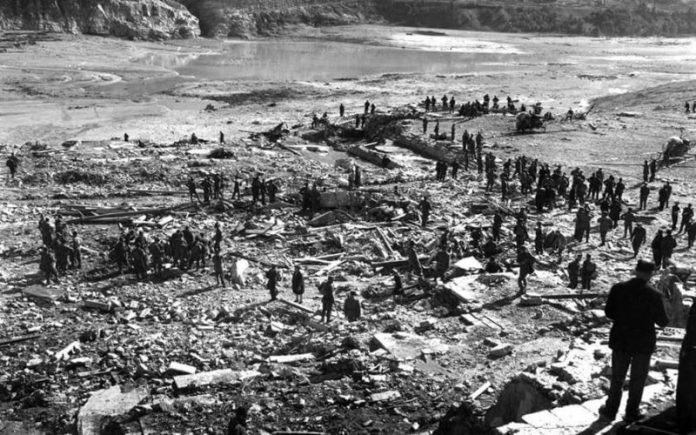by InTrieste
Today marks the 61st anniversary of one of Italy’s most devastating tragedies: the Vajont Dam disaster, which claimed the lives of nearly 2,000 people, including 487 children, in the Piave Valley of Friuli Venezia Giulia on October 9, 1963.
On that fateful night, a massive landslide from Monte Toc plunged into the artificial reservoir created by the 260-meter-high Vajont Dam, resulting in a catastrophic inland tsunami. The surge of water, reaching up to 200 meters above the dam, was unleashed by approximately 260 million cubic meters of rock that collapsed into the lake.
At 10:39 p.m., power in the surrounding area suddenly went out, just moments before the enormous wave, traveling at a speed of 80 kilometers per hour, thundered through the narrow valley. The town of Longarone was devastated, with 80 percent of its inhabitants—more than 300 families—wiped out in an instant. The neighboring villages of Faè, Pirago, Rivalta, and Villanova also suffered extensive destruction, and many victims’ bodies were never recovered.
The dam itself, designed in the 1920s by Italian engineer Carlo Semenza and completed in the late 1950s by the Società Adriatica di Elettricità (SADE), remarkably remained intact. It was built to harness the power of the Vajont River for hydroelectricity, serving the industrializing north of Italy. Despite multiple warnings that Monte Toc, located on the southern side of the reservoir, was geologically unstable, authorities dismissed the risks, with disastrous consequences.
The disaster left the Piave Valley shattered, its communities forever changed by the sudden, catastrophic event. The Vajont Dam, once hailed as an engineering marvel—the tallest of its kind in the world—has never been refilled, a silent monument to the lives lost.
Italian Prime Minister Giorgia Meloni, reflecting on the tragedy, described it as a “disaster that could and should have been prevented.” In a statement posted to social media platform X, she added, “After 61 years, we carry that scar in our memory and use it as a warning so that such calamities never happen again. Italy does not forget.”
Last year, President Sergio Mattarella visited the Fortogna cemetery to mark the 60th anniversary of the Vajont tragedy, paying tribute to those who perished. As the 61st anniversary approached, Veneto regional president Luca Zaia noted that the pain of the disaster remains “alive in so many people, so many families,” calling it a “still open wound.”
The Vajont Dam disaster remains a haunting reminder of the perils of disregarding nature’s warnings, and of the fragile balance between human ambition and environmental stewardship. Today, Italy honors the memory of those lost and vows to remember the lessons learned.





























